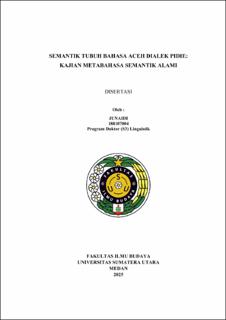Semantik Tubuh Bahasa Aceh Dialek Pidie: Kajian Metabahasa Semantik Alami
The Semantics of Acehnese Body Parts in the Pidie Dialect: A Natural Semantic Metalanguage Approach

Date
2025Author
Junaidi, Junaidi
Advisor(s)
Mulyadi
Iskandar, Denni
Rosa, Rusdi Noor
Metadata
Show full item recordAbstract
This research investigates the semantics of Acehnese body-parts in the Pidie dialect through NSM and RRG theoretical frameworks. This study addresses the categorization of body-parts lexical items using primes components, the ethno-anatomical and ethno-syntactic of the body, the argument structure and semantic roles of body-parts, and the cultural values embedded in semantics of body-parts. Oral data were collected using observational and interview techniques, while written data was obtained from 1930s manuscripts and Acehnese dictionaries. The analysis employed referential and distributional methods, the findings presented using both formal and informal approaches. Body-part terms are categorized based on SPACE and PART, further elaborated with primes such as KINDS and QUANTIFIERS, forming 5 following categories, namely UPPER BODY-PART, MIDDLE [M], LOWER BODY-PART, SIDE OF THE BODY, and ALL PARTS OF THE SIMILAR KINDS, each of which is further subdivided into subcategories and sub-subcategories based on the meaning components of NSM. Categorization was tested using semantic components of PARTONOMY, TOPOGRAPHY, MOBILITY, and FUNCTION. The semantic tests utilized the following components, (1) partonomy as quantifier + part + body, (2) topography as spatial elaborations such as inside, front side, back side, side of the body, above the part and below the part, (3) mobility consists of the elaboration of part+can+move, e.g., “part X can move like something, (4) Function consists of the elaboration of part+move+touch. Tests for polysemes and allolexes of body parts include stative, events and action verbs, prime na ‘be’, aspect markers ka ‘already’, modality golom, prime something, adjectives that describe the characteristics of body-parts, and perfective and imperfective aspects. For example, reukueng demonstrates polysemy, referring to both the esophagus and throat, while dhoe and talak are allolexes referring to the forehead. The NSM ethnosyntactic approach classifies the relationship between the body and its owner in Acehnese as either inalienable or alienable, based on whether a body part can be construed as possessed, marked by clitics and its syntactic patterns, e.g. autonomous subjects as seen in darah i léy ‘blood flows’ and i saih lé até ‘my heart whispered to me’. In contrast, non-autonomous objects, such as i raih aroe jih ‘he washes his hands’ exhibit possessive relations. Alienability is further evidenced by the RRG Theory, whereby body-parts exhibit [+control] agentives, functioning as agents (X), as if they were detached from the body’s owner. Body parts roles as undergoer (U) in non [-control] verb situations with the prefix teu- which indicates an event in which (Y) functions as a patient. Morphologically, Verbs derivation with the prefix meu- occurs in control and non-control types. Thematic relationships related to body parts, such as agent, patient, experiencer, theme, stimulus, locative and influencer. Body parts role as non-core arguments, such as locative oblique, instrumental oblique and adjunct. The findings of the meaning of body parts in the ethnopragmatic of NSM are explained using phraseology and hadih maja to reveal cultural scripts and values of Acehnese body-parts.
